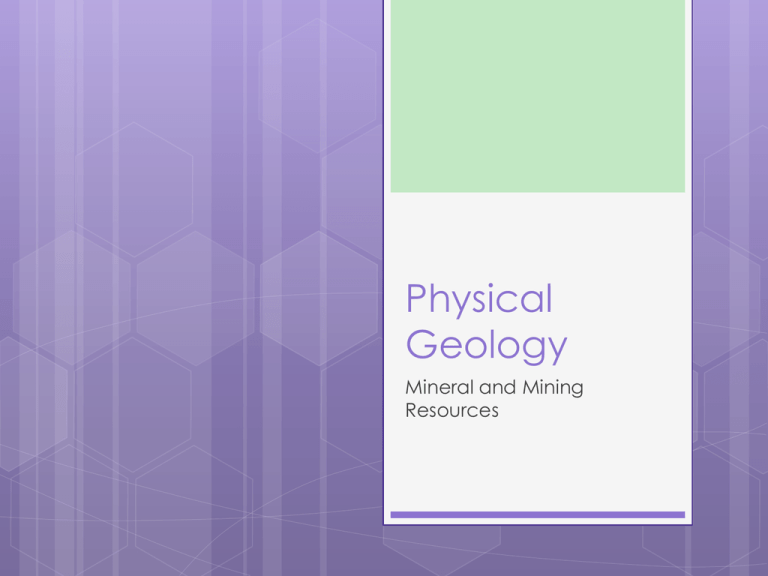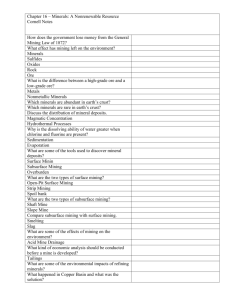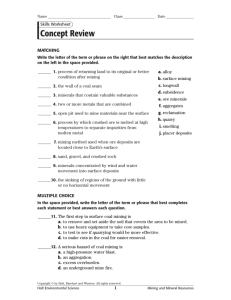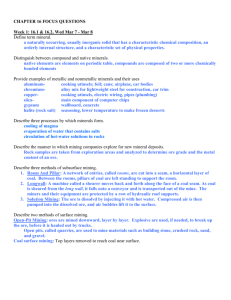Lecture 2 Minerals and Mining Resources
advertisement

Physical Geology Mineral and Mining Resources Ore Minerals Minerals that are valuable and economical to extract are known as ore minerals Minerals that have no commercial value are called gangue minerals Several separation techniques are used to separate ore or gangue minerals Ore Minerals Ore minerals are further refined to extract the valuable elements For mining to be profitable, the price of the final product must be greater than the costs of extraction and refining. Mineral Resources and Their Uses Some minerals are of major economic and industrial importance Some metals can be pressed into various shapes or stretched very thinly without breaking Others are good conductors of heat and electricity Some are prized for their durability and resistance to corrosion. Mineral Resources and Their Uses Often two or more metals are combined to form alloys Alloys are important because they combine the most desirable properties of the metals used to make them Mineral Resources and Their Uses Some nonmetallic minerals are called gemstones and are prized purely for their beauty, rarity, or durability Important gemstones include: Diamond Ruby Sapphire Emerald Aquamarine Topaz Tourmaline Mineral Exploration The first step in finding an ore deposit is exploring rock for mineralization Planes can identify patterns in gravity, magnetism, or radioactivity Data and aerial photographs can be used to create geologic maps of the surface Mineral Exploration Samples grade are analyzed to determine ore If the ore grade is high enough and the deposit extensive enough, the cost to open a mine may be warranted Types of Mining Subsurface Mining Surface Mining Placer Mining Subsurface Mining Ore deposits that are usually found 50 m or more beneath Earth’s surface are mined via subsurface mining The most common method is room-andpillar mining used to mine coal and salt Subsurface Mining Between the rooms, pillars of coal are left standing to support the roof When the mining of rooms is completed, the pillars are then removed, beginning with pillars at the farthest point in the mine. Surface Mining Surface mining methods are used when ore deposits are located close to Earth’s surface Open-pit mining is a method that is often used to mine large quantities of near-surface ore Coal and metals like copper are mined using open-pit method Ore is mined downward, layer by layer Placer Mining When rock weathers, minerals within the rock are released These minerals are concentrated by wind and water into surface deposits called placer deposits The most important place deposits are stream places Undersea Mining The ocean floor contains significant mineral resources, which include diamonds, precious metal such as gold and silver, mineral ores, and sand and gravel Since the late 1950s, several attempts have been made to mine the ocean Land-based companies can mine mineral more cheaply is a main reason undersea mining is unsuccessful. Mining Reclamation Mines on land in the United States are regulated by federal and states laws Reclamation The process of returning land to its original or better condition after mining is completed is called reclamation Mining Reclamation The Surface Mining Control and Reclamation Act of 1977 created a program for the regulation of surface coal mining on public and private land The act set standards that would minimize the surface effects of coal mining on the environment.









